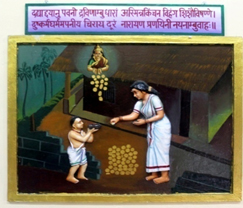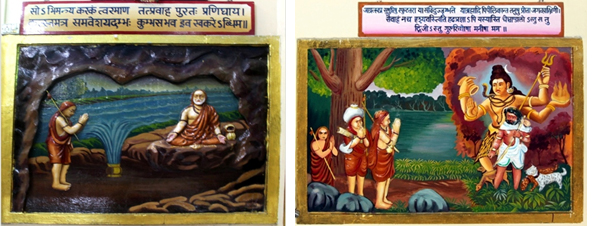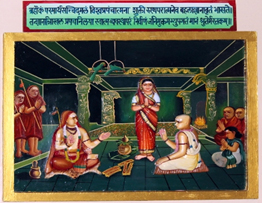The Walls of Stairs
ARCHITECTURAL BEAUTY IN THE WALLS OF STAIRS LEADING TO THE TEMPLE
Adi Sankara is a great Guru of Advaita philosophy, an incarnation of Adiguru Lord Dakshinamurthy who imparted Atma Vidya to save us from the forest of Ajnana & forest fire of worldly existence. He resuscitated the pristine glory of the Vedic tradition and the Advaitic philosophy & established the Shanmatha worship laying a path for Advaita jnana Yogyata.
Adi Sankara traversed on foot across Bharatdesa and by His solid reasoning, He established with profound clarity, that there is only one Infinite Reality against many conflicting theories. There were 72 schools of thought when Adi Sankara appeared on the scene.
Adi Sankara was born to Shivaguru & Aryambal at Kalady in Kerala after a long tapas with shraddha bhakti and as told to them in their dreams. In the dream, they were asked, whether they wanted many long lived stupid sons or one learned son who would be short lived. They said they would abide by the will of God himself. At the age of five, Adi Sankara was initiated into Vedic studies after Aksharabhasyam and Upanayana Samskaram. At the age of eight, he master all the four Vedas.
The stairs leading to the temple is an architectural beauty covering the various facets of Adi Sankara

As a brahmachari on a Dwadasi day, Sankara happened to go to the house of a very poor lady and asked for Biksha. She had nothing but an Amla fruit and gave it to him immediately, as she would not send the brahmachari empty handed. Sankara was moved by her selflessness and poverty and prayed to Goddess Lakshmi in a beautiful “Kanaka Dhara Stotram”. Goddess Lakshmi appeared in person and showered a rain of golden coin on the poor lady’s house.
While bathing in the river one day, a crocodile caught hold of his leg. Sankara appealed to his mother (his father having predeceased her) at this moment, for permission to become a sanyasi. The first occasion was a dilemma relating to his birth while this one to his death. She consented to his choice of becoming a sanyasi & the crocodile disappeared. He then went to the North in search of a Guru and took Sanyasam from Sri Govinda Bhagavadpadacharya on the banks of river Narmada and learnt under him.

Once river Narmada was gushing forth into floods. Adi Sankara encapsulated it in his Kamandal by using his yogic powers and then released it in the banks of the river.

In Kasi, when Adi Sankara was going to the Vishwanath temple, one day, an outcaste crossed his way and was beckoned to keep a distance. The Chandala smiled and exclaimed, whether his body made of food was asked to move, or his consciousness. Adi Sankara immediately realized that it was Lord Siva himself and responded in Manisha Panchakam that “If one is convinced that He is the pure consciousness and not the visible body, he is the wisest man, be he of a higher caste or an outcaste.
Once an old Brahmin started intelligent samvadam with Adi Sankara about his Brahmasutra Bashyam. The debate went on for days together, neither disputant getting the better of the other. Amazed at this, Adi Sankara’s disciple Padmapada discerned by divine vision (jnana drishti) that the old man was none other than Vyasa himself and exclaimed :
Sankaras sankarassakhshaat vyaso naraayano harih!
Tayoh vivaade sampraapte kinkarah kim karomyaham!

Adi Sankara is Bhagavan Sankara himself and Vyasa is Hari, the Supreme Narayana. When these two are engaged in debate, what can I, humble attendant do? Veda Vyasa Bhagwan, who was author of Brahmasutra said “Sankara, I fully agree with your bashyam/commentary” and gave him a lease of life of another 16 years. He also desired that Adi Sankara should travel throughout Bharatadesa and establish the philosophy of Advaita Siddhanta.

Adi Sankara sought a debate with Kumarila Bhatta in Prayag. Kumarila Bhatta had learnt philosophy from a Buddhist Guru under false pretenses of being a Buddhist, in order to be able to refute it. To repent for this sin of learning without the knowledge of his Guru, while still under his authority, he had buried himself in a slow burning fire. So he asked Adi Sankara to debate with Mandana Misra instead.
Adi Sankara debated with Mandana Mishra, with Saraswani, Mandana Mishra’s wife being the referee. Adi Sankara won the debate with Mandana Mishra whose philosophy was Karma Mimamsa and also answered all the brilliant questions of Sarasawani. They became his disciples. Similarly, he won debates with many others establishing the Advaitic philosophy.

It is clear that His life is a teaching. “Learn to abide by Dharma and be giving like the poor lady; come out of Samsara Sagara as Adi Sankara did when caught by the crocodile; Thereafter, seek and learn under a Guru that – you are the pure consciousness (Brahman) and not the visible body/Jiva as extolled to the Chandala; have good clarity to be able to explain Vedanta” – Doesn’t his life sound like a synopsis of his final Sadhana Panchakam?
Within the 32 years that Adi Sankara remained in human form and traversed this great Bharatadesa, he has written detailed commentaries to the Prasthana Trayam namely Brahmasutra, 10 principal Upanishads and Bhagavad Gita apart from composing various other Prakarana Grantha texts and innumerable Slokas instilling Jnana & Bhakti. But for Adi Sankara’s lucid explanatory Bashyams/commentaries and compositions, it would have been difficult to comprehend Vedanta.
One example – a verse from Adi Sankara’s Bhaja Govindam would sum it up :
